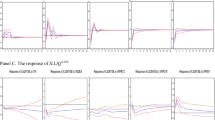Abstract
The aim of this paper is to analyze the dynamic evolution of six liquidity proxies on time and to find their causality with the French CAC 40 stock market index returns, over the period from January 2007 to December 2018. To this end, we use a vector autoregressive approach and the impulse response function and we perform the Granger causality test between the CAC 40 index returns and six different liquidity proxies. Empirical results suggest a significant short-term relationship between the returns and the liquidity. As for causality test, the results reveal that there is unidirectional causality running from returns to liquidity.






Similar content being viewed by others
Data availability statement
Manuscript contains data which will be made available on a reasonable request.
References
Abdi F, Ranaldo A (2017) A simple estimation of bid-ask spreads from daily close, high, and low prices. Rev Financ Stud 30(12):4437–4480
Acharya VV, Pedersen LH (2005) Asset pricing with liquidity risk. J Financ Econ 77(2):375–410
Amihud Y (2002) Illiquidity and stock returns: cross-section and time-series effects. J Financ Mark 5(1):31–56
Amihud Y, Mendelson H, Pedersen LH et al (2006) Liquidity and asset prices. Found Trends Finance 1(4):269–364
Baldauf M, Mollner J (2021) Fast traders make a quick buck: the role of speed in liquidity provision. J Finan Markets 100621
Bekaert G, Harvey CR, Lundblad C (2007) Liquidity and expected returns: Lessons from emerging markets. Rev Financ Stud 20(6):1783–1831
Chang YY, Faff R, Hwang C-Y (2010) Liquidity and stock returns in japan: New evidence. Pac Basin Finance J 18(1):90–115
Chen G-M, Firth M, Rui OM (2001) The dynamic relation between stock returns, trading volume, and volatility. Financ Rev 36(3):153–174
Chordia T, Roll R, Subrahmanyam A (2000) Co-movements in bid-ask spreads and market depth. Financ Anal J 56(5):23–27
Corwin SA, Schultz P (2012) A simple way to estimate bid-ask spreads from daily high and low prices. J Finance 67(2):719–760
Czauderna K, Riedel C, Wagner N (2015) Liquidity and conditional market returns: evidence from German exchange traded funds. Econ Model 51:454–459
Danyliv O, Bland B, Nicholass D (2014) Convenient liquidity measure for financial markets. ERN: Other Econometric Modeling: Capital Markets - Asset Pricing (Topic)
Donadelli M, Prosperi L (2012) On the role of liquidity in emerging markets stock prices. Res Econ 66(4):320–348
Eisler Z, Kertész J (2007) Liquidity and the multiscaling properties of the volume traded on the stock market. Europhys Lett 77(2):28001
Fong KY, Holden CW, Trzcinka CA (2017) What are the best liquidity proxies for global research? Rev Finance 21(4):1355–1401
Foucault T, Pagano M, Roell A, Röell A (2013) Market liquidity: theory, evidence, and policy. Oxford University Press, Oxford
Gębka B (2012) The dynamic relation between returns, trading volume, and volatility: Les- sons from spillovers between asia and the united states. Bull Econ Res 64(1):65–90
Goyenko RY, Holden CW, Trzcinka CA (2009) Do liquidity measures measure liquidity? J Financ Econ 92(2):153–181
Granger CW (1969) Investigating causal relations by econometric models and cross-spectral methods. Econometrica 37:424–438
Harris L (1990) Statistical properties of the roll serial covariance bid/ask spread estimator. J Finance 45(2):579–590
Harris L (2003) Trading and exchanges: market microstructure for practitioners. OUP, Oxford
Hasbrouck J (2009) Trading costs and returns for US equities: estimating effective costs from daily data. J Finance 64(3):1445–1477
Hasbrouck J, Seppi DJ (2001) Common factors in prices, order flows, and liquidity. J Financ Econ 59(3):383–411
Hendershott T, Jones CM, Menkveld AJ (2011) Does algorithmic trading improve liquidity? J Financ 66(1):1–33
Holden CW, Nam J (2019) Do the LCAPM predictions hold? Replication and extension evidence. Crit Finance Rev 8(1–2):29–71
Kazumori E, Fang F, Sharman R, Takeda F, Yu H et al (2019) Asset pricing with liquidity risk: a replication and out-of-sample tests with the recent us and the Japanese market data. Crit Finance Rev 8(1–2):73–110
Laruelle S, Lehalle C-A (2018) Market microstructure in practice. World Scientific, London
Lee B-S, Rui OM (2002) The dynamic relationship between stock returns and trading volume: domestic and cross-country evidence. J Bank Finance 26(1):51–78
Lesmond DA (2005) Liquidity of emerging markets. J Financ Econ 77(2):411–452
Marshall BR, Young M (2003) Liquidity and stock returns in pure order-driven mar- kets: evidence from the australian stock market. Int Rev Financ Anal 12(2):173–188
Mugoué M, Aggarwal R (2011) Trading volume and exchange rate volatility: evidence for the sequential arrival of information hypothesis. J Bank Finance 35(10):2690–2703
Pástor L, Stambaugh RF (2003) Liquidity risk and expected stock returns. J Polit Econ 111(3):642–685
Rjoub H (2012) Stock prices and exchange rates dynamics: evidence from emerging markets. Afr J Bus Manag 6(13):4728–4733
Roll R (1984) A simple implicit measure of the effective bid-ask spread in an efficient market. J Finance 39(4):1127–1139
Saatcioglu K, Starks LT (1998) The stock price–volume relationship in emerging stock markets: the case of latin america. Int J Forecast 14(2):215–225
Sims CA (1980) Macroeconomics and reality. Econometrica 48:1–48
van den End JW, Tabbae M (2012) When liquidity risk becomes a systemic issue: Empirical evidence of bank behaviour. J Financ Stab 8(2):107–120
Van Kervel V, Menkveld AJ (2019) High-frequency trading around large institutional orders. J Finance 74(3):1091–1137
Vu V, Chai D, Do V (2015) Empirical tests on the liquidity-adjusted capital asset pricing model. Pac Basin Financ J 35:73–89
Wang J, Chen L (2012) Liquidity-adjusted conditional capital asset pricing model. Econ Model 29(2):361–368
Weller BM (2018) Does algorithmic trading reduce information acquisition? Rev Financ Stud 31(6):2184–2226
Funding
No external funding has been received.
Author information
Authors and Affiliations
Corresponding author
Ethics declarations
Confict of interest
There is no conflict of interest.
Informed consent
This study enjoys the consent of all its authors.
Rights and permissions
About this article
Cite this article
Assoil, A., Ka, N. & Sadefo-Kamdem, J. Analysis of the dynamic relationship between liquidity proxies and returns on the French CAC 40 index. SN Bus Econ 1, 129 (2021). https://doi.org/10.1007/s43546-021-00129-7
Received:
Accepted:
Published:
DOI: https://doi.org/10.1007/s43546-021-00129-7




